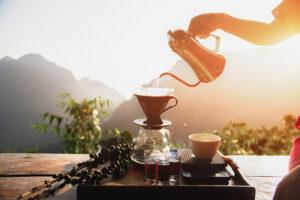Poured, not dripped, please – All about pour-over coffee
Pour-over coffee is a favored way among enthusiasts to brew coffee. Some pros are that it gives a clean cup of coffee and makes the finished product simple yet elegant. Some may consider cons are the amount of attention that needs to be paid to the brewing method. From wetting the filter with 150-degree water to coffee ratios, usually 16:1 or less commonly 15:1, the ground size and water temp at extraction. My parameters are as much as possible coarse ground, water temp 200-degree water, and about 4-5 tablespoons of coffee to a kettle of water which is .8 liters. The filter I used was a Melita # 4 paper filter. The coffees I used were the Lavazza Classico roast, Gevalia single origin Guatemala coarse, and Eight o clock original roast whole bean. Before diving headfirst into the coffee and taste, let’s do some fast time travel.
It is the early 1900s in Europe, and the on-vogue brewing style was immersion brewing. And with that comes some silt and sludge from the coffee in your cup. The other option is a straightforward espresso machine. However, Mrs. Melita Bentz was not pleased with the current status quo, so she took a pot, poked some holes in it, placed some paper at the bottom for a filter, and brewed coffee with it. Being pleased with the end product, she refined the mechanism some more, and in 1908 she was granted a patient, for now, famous #4 filter. Funny enough, Mrs. Bentz was a German housewife. Who started a company out of her house and grew it substantially and forever changed coffee. Mind you. It would be appropriate to mention that she is still a wife and a mother while starting a company. Sadly for the sake of time, I must wrest the reader from their fantasy European café back to reality to discuss the devices that use the #4 filter.

Now, pour-over describes what happens. There are three main pour-over styles: the v60, which looks like a teacup saucer combo with a slight opening at the bottom, the Kalita wave, and the Cemex. I prefer the Bodum pour-over, a copy of the Cemex coffee maker. I used it for this test to discuss the coffees mentioned above. The reasons I chose the Bodum are the price and the capacity. Unlike the v60 and the wave, the Cemex style brewer makes enough to share should I choose. So let’s get into the coffee.
Ideally, for pour-over coffee, you want a coarse enough coffee to prevent under-extraction but not fine enough to over-extract the coffee. Furthermore, from what I have read, linked below, medium-light to medium roast is where you want to be for the best results. But as always, do not let recommendations stop you from using what’s on hand to make coffee in this style.
The first coffee was an Eight o clock original blend, which is said to be a medium to med-light roast. I ground this coffee three different times at three different sizes in my Krups burr grinder. From the coarsest down to a 7. for the high hopes I had, this was the most disappointing coffee of the three. It was mainly hot water with finishing notes of chocolate. The second coffee in the lineup was the Gevalia Guatemalan single-origin coarse ground. This coffee was oily and slightly acidic. The tasting notes were cinnamon and dark chocolate, which reminded me of Mexican hot chocolate. It could be a great way to get into this brewing style with not too much going on. Because it is already grounded, it takes one variable out and one step closer to a good cup of coffee. Finally, Lavazza Classico was slightly bitter and acidic with dark chocolate and heavy oils. The intensity and the flavors’ loudness put it just outside of beginner level. Overall, the pour-over brought out the flavors, oils, and acidity of the coffee while keeping the mess in the filter. The finished products did not require additives like milk or sugar, which I typically add when drinking drip or pod-style coffees. These coffees held my attention by themselves. At least the coffees tested held less complexity than I would like but would serve perfectly well for the start of the day. The goal in picking the coffee was something everyone could get that way; you could do some testing/evaluating on your own.
Pour-over can transform coffee from boring to dynamic by taking the machine out and putting a man in. It allows us to train to be an artisan. To truly stretch the creative part of our brains and challenge our capabilities. Despite being relatively new to the coffee scene being in-between immersion brewing and drip brewers, it has undoubtedly changed how people can and have enjoyed coffee for the better. I would be remiss if there were no space given to honor the contribution of Mrs. Bentz and her filters. Finally, enjoy the coffee and the process; we would love to hear what you all find.
by David Jeffries




Comments are closed.